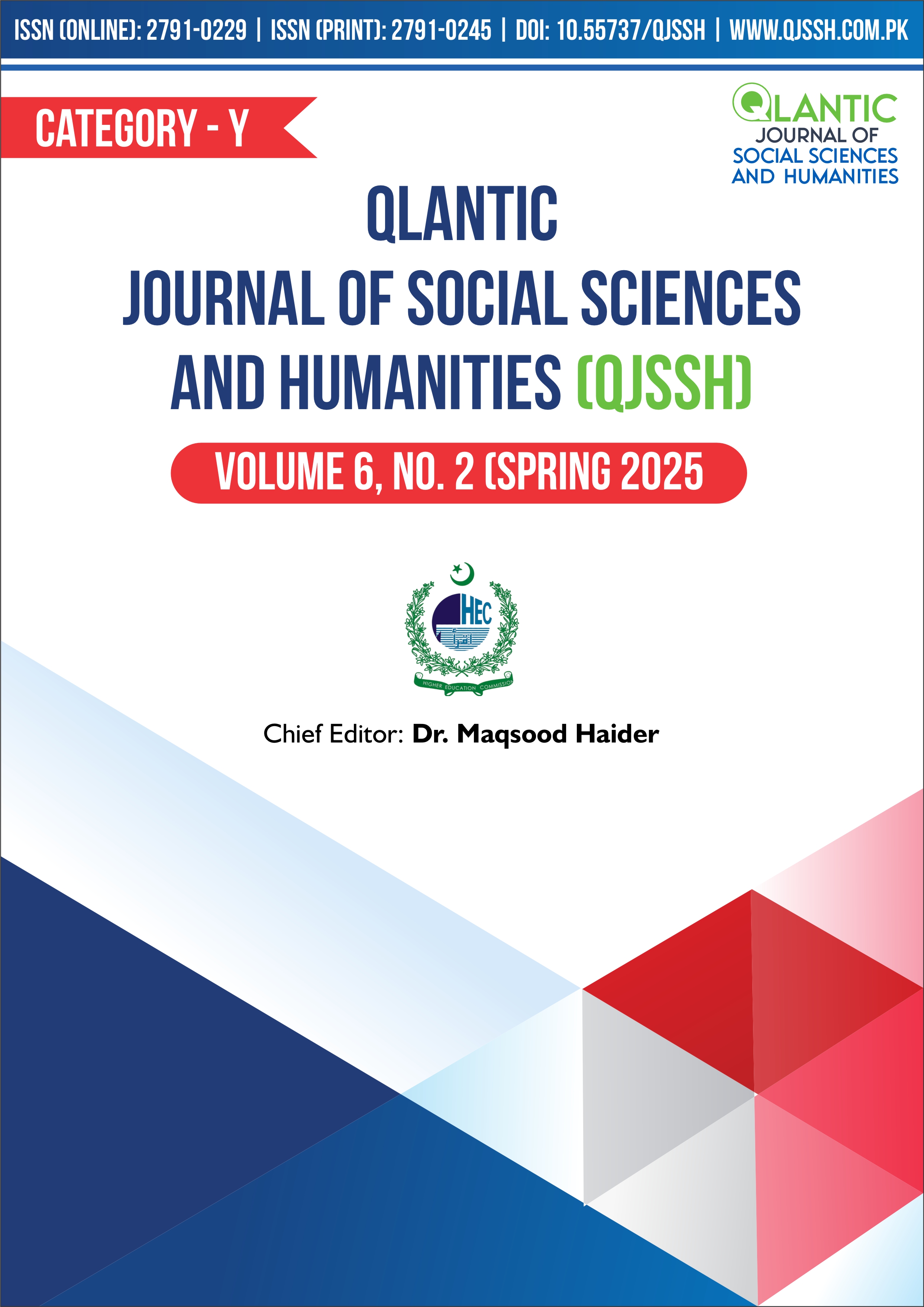A Socio-Psychological Triggers of Criminal Behavior Among Serial Killers Associated with Recidivism: A Case Study of Sargodha City
DOI:
https://doi.org/10.55737/qjssh.vi-ii.25353Keywords:
Socio-Psychological Factors, Recidivism, Social Environment, Antisocial Behavior, Serial KillersAbstract
Murder is considered to be the most heinous and serious crime since it involves the unlawful killing of another person. One of the categories that is separated according to the intensity of the offense is intentional murder. Despite the presence of law enforcement and a proper legal framework, killing or purposefully injuring someone is a delicate and inappropriate conduct that has become widespread. The main objective of this research is to investigate how group dynamics and societal factors contribute to recidivism and also the internal and external driving forces behind such antisocial behaviors and the reasons why people commit such felony crimes in spite of the law and its consequences. People who engage in such practices on a regular basis known as serial killers, are basic subject of the study. The researchers selected Sargodha city as the universe of study to explore disparities in the attitudes and conduct of serial killers. The socio-psychological characteristics of murderers are investigated using a qualitative method and a non-probability sampling strategy. Criminal profiling and creating the reality underlying such antisocial behavior are two applications of the thematic approach. The results of the study demonstrate that seeking retribution is a cultural value that is thought to be essential for survival and social standing. A significant contributing factor to the spate of killings in Sargodha city is the desire for power and wealth.
References
Allely, C. (2020). The psychology of extreme violence: A case study approach to serial homicide, mass shooting, school shooting and lone-actor terrorism. Routledge.
Allely, C. S., Minnis, H., Thompson, L., Wilson, P., & Gillberg, C. (2014). Neurodevelopmental and psychosocial risk factors in serial killers and mass murderers. Aggression and Violent Behavior, 19(3), 288–301. https://doi.org/10.1016/j.avb.2014.04.004
Anderson, J. F., & Kras, K. (2005). Revisiting Albert bandura’s social learning theory to better understand and assist victims of intimate personal violence. Women & Criminal Justice, 17(1), 99–124. https://doi.org/10.1300/j012v17n01_05
Arndt, W. B., Hietpas, T., & Kim, J. (2004). Critical characteristics of male serial murderers. American Journal of Criminal Justice: AJCJ, 29(1), 117–131. https://doi.org/10.1007/bf02885707
Arrigo, B. A., & Purcell, C. E. (2001). Explaining paraphilias and lust murder: Toward an integrated model. International Journal of Offender Therapy and Comparative Criminology, 45(1), 6–31. https://doi.org/10.1177/0306624x01451002
Caspi, A., Roberts, B. W., & Shiner, R. L. (2005). Personality development: stability and change. Annual Review of Psychology, 56(1), 453–484. https://doi.org/10.1146/annurev.psych.55.090902.141913
Crego, C., & Widiger, T. A. (2016). Cleckley’s psychopaths: Revisited. Journal of abnormal psychology, 125(1), 75-87. https://psycnet.apa.org/doi/10.1037/abn0000130
DeFronzo, J., Ditta, A., Hannon, L., & Prochnow, J. (2007). Male serial homicide: The influence of cultural and structural variables. Homicide Studies, 11(1), 3-14. https://doi.org/10.1177/1088767906297434
DeLisi, M., Piquero, A. R., & Cardwell, S. M. (2016). The unpredictability of murder: Juvenile homicide in the pathways to desistance study. Youth violence and juvenile justice, 14(1), 26-42. https://doi.org/10.1177/1541204014551805
Djamba, Y. K., & Neuman, W. L. (2002). Social research methods: Qualitative and quantitative approaches. Teaching Sociology, 30(3), 380. https://doi.org/10.2307/3211488
Dutton, D. G., & Hart, S. D. (1992). Risk markers for family violence in a federally incarcerated population. International Journal of Law and Psychiatry, 15(1), 101–112. https://doi.org/10.1016/0160-2527(92)90030-5
Fazel, S., Wolf, A., Palm, C., & Lichtenstein, P. (2014). Violent crime, suicide, and premature mortality in patients with schizophrenia and related disorders: a 38-year total population study in Sweden. The Lancet. Psychiatry, 1(1), 44–54. https://doi.org/10.1016/S2215-0366(14)70223-8
Ferguson, B. R., Odegard, R., & Weatherby, G. A. (2014). Concealed carry permits: Catalyst or deterrent? A state-by-state look into how a change from no-issue to shall-issue affects crime rates. Journal of law and criminal justice, 2(1), 241-272. https://jlcj.thebrpi.org/vol-2-no-1-march-2014-abstract-12-jlcj
Fergusson, D. M., Horwood, L. J., & Ridder, E. M. (2005). Partner violence and mental health outcomes in a New Zealand birth cohort. Journal of Marriage and the Family, 67(5), 1103–1119. https://doi.org/10.1111/j.1741-3737.2005.00202.x
Fox, J. A., & Levin, J. (2022). Mass murder in America: Trends, characteristics, explanations, and policy response. Homicide Studies, 26(1), 27–46. https://doi.org/10.1177/10887679211043803
Hare, R. D. (1991). Psychopathy Checklist—Revised [Database record]. APA PsycTests. https://doi.org/10.1037/t01167-000
Holmes, R. M., & Holmes, S. T. (2009). Serial murder. SAGE.
Holmes, R. M., De Burger, J., & Holmes, S. T. (1988). Inside the mind of the serial murder. American Journal of Criminal Justice: AJCJ, 13(1), 1–9. https://doi.org/10.1007/bf02890847
Holmes, S. T., & Holmes, R. M. (2012). Homicide, serial murder, and mass murder. In Routledge Handbook of Deviant Behavior (pp. 518-526). Routledge.
Huesmann, L. R., & Kirwil, L. (2007). Why observing violence increases the risk of violent behavior in the observer. Cambridge University Press.
Last, S. K., & Fritzon, K. (2005). Investigating the nature of expressiveness in stranger, acquaintance and intrafamilial homicides. Journal of Investigative Psychology and Offender Profiling, 2(3), 179–193. https://doi.org/10.1002/jip.36
Mabia, c. E. (2019). Percieved social support, moral disengagement and decision making styles as predictors of tendency to commit crime among undergraduates in anambra state [Dissertation]. Nnamdi Azikiwe University, AWKA.
Macdonald, J. M. (1963). The threat to kill. The American Journal of Psychiatry, 120(2), 125–130. https://doi.org/10.1176/ajp.120.2.125
McCullough, M. E., Kurzban, R., & Tabak, B. A. (2011). Evolved mechanisms for revenge and forgiveness. In P. R. Shaver & M. Mikulincer (Eds.), Human aggression and violence: Causes, manifestations, and consequences (pp. 221–239). American Psychological Association. https://doi.org/10.1037/12346-012
McGinnis, K. (2009). The Buller-McGinnis Model of Serial Homicidal Behavior: An Integrated Approach. Journal of Criminology and Criminal Justice Research, 3(1).
Psaila Brancaleone, D. (2022). The psychology behind serial killers: what drives one to commit such crimes? (Bachelor's thesis, University of Malta).
Rhee, S. H., & Waldman, I. D. (2002). Genetic and environmental influences on antisocial behavior: a meta-analysis of twin and adoption studies. Psychological Bulletin, 128(3), 490–529. https://doi.org/10.1037//0033-2909.128.3.490
Schlagbaum, P., Tissue, J. L., Sheftall, A. H., Ruch, D. A., Ackerman, J. P., & Bridge, J. A. (2021). The impact of peer influencing on adolescent suicidal ideation and suicide attempts. Journal of Psychiatric Research, 140, 529–532. https://doi.org/10.1016/j.jpsychires.2021.06.027
Sharma, M. (2018). The development of serial killers: A grounded theory study. Master’s Theses. 3720. https://thekeep.eiu.edu/theses/3720
Silverman, J. J., Galanter, M., Jackson-Triche, M., Jacobs, D. G., Lomax, J. W., 2nd, Riba, M. B., Tong, L. D., Watkins, K. E., Fochtmann, L. J., Rhoads, R. S., Yager, J., & American Psychiatric Association. (2015). The American psychiatric association practice guidelines for the psychiatric evaluation of adults. The American Journal of Psychiatry, 172(8), 798–802. https://doi.org/10.1176/appi.ajp.2015.1720501
Skeem, J. L., & Cooke, D. J. (2010). Is criminal behavior a central component of psychopathy? Conceptual directions for resolving the debate. Psychological Assessment, 22(2), 433–445. https://doi.org/10.1037/a0008512
Stein, A., & Stern, D. B. (2013). Prologue to violence: Child abuse, dissociation, and crime. Routledge.
Toews, M. L., McKenry, P. C., & Catlett, B. S. (2003). Male-initiated partner abuse during marital separation prior to divorce. Violence and victims, 18(4), 387-402. http://dx.doi.org/10.1891/vivi.2003.18.4.387
Trochim, W. M., Marcus, S. E., Mâsse, L. C., Moser, R. P., & Weld, P. C. (2008). The evaluation of large research initiatives: a participatory integrative mixed-methods approach. American Journal of Evaluation, 29(1), 8-28. https://doi.org/10.1177/1098214007309280
Van Dorn, R., Volavka, J., & Johnson, N. (2012). Mental disorder and violence: is there a relationship beyond substance use? Social psychiatry and psychiatric epidemiology, 47, 487-503. https://doi.org/10.1007/s00127-011-0356-x
Walters, B. K., Drislane, L. E., Patrick, C. J., & Hickey, E. (2015). Serial murder: Facts and misconceptions. Science and the Courts, 1(5), 32-41.
Waytz, A., & Schroeder, J. (2014). Overlooking others: Dehumanization by comission and omission. TPM: Testing, Psychometrics, Methodology in Applied Psychology, 21(3). https://www.tpmap.org/wp-content/uploads/2015/11/21.3.2.pdf
Whitman, T. A., & Akutagawa, D. (2004). Riddles in serial murder: A synthesis. Aggression and Violent Behavior, 9(6), 693–703. https://doi.org/10.1016/j.avb.2003.08.003
Zagar, R. J., Busch, K. G., Grove, W. M., Hughes, J. R., & Arbit, J. (2009). Looking forward and backward in records for risks among homicidal youth. Psychological Reports, 104(1), 103–127. https://doi.org/10.2466/PR0.104.1.103-127
Downloads
Published
Issue
Section
License

This work is licensed under a Creative Commons Attribution-NonCommercial 4.0 International License.





